Body and Soul
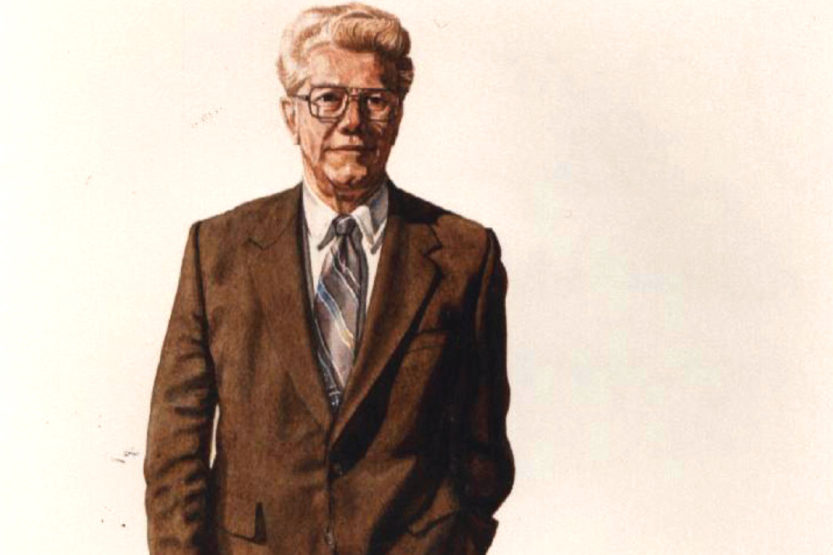 UI professor and disabilities rights leader Timothy Nugent. (Photo courtesy of College of AHS)
UI professor and disabilities rights leader Timothy Nugent. (Photo courtesy of College of AHS) For the most part, the world is run by people whose bodies are whole. If you ask them to slow down or otherwise sacrifice on behalf of those whose bodies are not, people will raise their voices, call you unreasonable or simply ignore you.
But if you keep asking for — no, demanding — fair consideration, day after day, year after year, slowly they’ll give ground. And after 63 years you’ll get what you have at the University of Illinois. Curb cut by curb cut, ramp by ramp, the University has evolved into a one-of-a-kind, life-changing force for students with disabilities.
The Division of Disability Resources and Educational Services (DRES) is a mouthful of a title for a simple but radical concept, which is to make college more accessible for students with disabilities. That’s just an umbrella phrase, however. Serving hundreds of students each year, DRES has long been a leader in its field. Illinois was the first campus with curb cuts, wheelchair-accessible bus routes and adaptive sports (Illinois’ programs are considered the New York Yankees of collegiate wheelchair athletics). Many of the nation’s accessibility laws trace their roots to Urbana-Champaign.
“The purpose of this unit is to ensure that the brightest young people with severe disabilities — and with broad ranges of disabilities — are afforded egalitarian access to resources of this campus and benefit to the greatest degree possible, similar to the benefit that’s granted all other students,” says DRES Director Brad Hedrick, PHD ’84 AHS. “That’s a pretty exciting mission.”
The program is housed in the Rehabilitation Education Center, which sits among a cluster of nondescript buildings on the south side of campus. It’s a good distance from most campus academic buildings, but in a way it’s a fitting spot, surrounded on all sides by power plants, labs, chiller plants, workshops and other brass tacks of the University. Talk to anyone touched by a disability, and you’ll know that rehabilitation is part brain, part guts, part sweat and part mechanical.
Look around the lobby of that building, however, and it’s clear that DRES’ mission is also an inspirational one. On one wall, near a trophy case of honors collected by Illinois wheelchair athletes, is a portrait of Tim Nugent by the late artist Billy Morrow Jackson, MFA ’54. It says something of Nugent’s impact that DRES keeps his portrait hanging some 25 years after his retirement. But what really makes you pause to consider the man is a peculiar feature added by the artist: Nugent, who does not have a disability, is casting the shadow of a wheelchair.
‘The Visioner’
Any story about DRES needs to start with Nugent. He was the program’s first director when it was created in the late 1940s and called the Rehabilitation Program, geared primarily toward wounded war veterans. Nugent arrived at age 24, fresh from graduate school at the University of Wisconsin, and he’d stay at Illinois until his retirement in 1986.
Highlights of his career are too many to list, but they include citations from presidents Eisenhower and Clinton; the founding of Delta Sigma Omicron, a national fraternity dedicated to serving those with disabilities; the establishment of the first National Wheelchair Basketball Tournament; and the research and advancement of architectural standards that would be built into laws adopted across the country.
A 2002 history by the Rehabilitation Research and Training Center on Independent Living Management says that Nugent created a program that “became a prototype for disabled student programs and independent living centers.”
Around DRES these days, Nugent is affectionately referred to with such titles as “the Visioner,” but during his career, he didn’t necessarily achieve those visions by being Mr. Nice Guy. Former students recall facing reprimands — even expulsion — for failing to meet Nugent’s high standards, including pushing your own wheelchair and otherwise striving for independence.
In “The History of Discrimination in U.S. Education: Marginality, Agency, and Power,” former student Jan Little ’61 MEDIA, MS ’65 MEDIA, recalls a love/hate relationship with Nugent that was 99.9 percent love and 0.1 percent hate. “The 0.1 percent hate turned out to be the factor that made many of us succeed when all odds were against success,” she recalls.
***
Evelyn Moore ’69 LAS arrived at the University Illinois in the 1960s with partial use of her hands and arms. Before she left, she had learned to drive.
Nugent was talking to a visiting doctor one day when Moore drove up in a convertible. “The doctor said, ‘Gee, she looks familiar,'” Nugent recalls. “I said, ‘She should. She was your patient.’ He said, ‘Oh my God, I discharged her with an attendant 24 hours a day.’ I said, ‘Would you like to go for a drive with her in her new car?'”
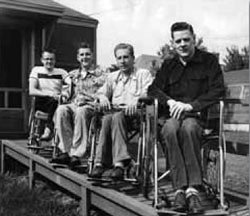
A ramp offers easier access to living quarters.
Photo courtesy of College of AHS
Making Inroads One at a Time
Nugent, now in his late 80s, still lives in Champaign with his wife in a leafy subdivision just a few doors away from his grandkids. He still advises DRES, attends all of the wheelchair basketball tournaments and recalls keenly his working days at the U of I. At times his voice hardens. In the early days, the University and DRES didn’t always see eye-to-eye.
When Nugent arrived in 1948, the Rehabilitation Program was located at the University’s former Galesburg campus. Almost immediately, news came down that the University planned to close that campus and the Rehabilitation Program along with it. Nugent and his students protested at the state capital and at Urbana to keep the program alive.
The program was eventually spared and relocated to Urbana-Champaign, where the roughly dozen or so students were housed in tar-paper U.S. Army surplus barracks. Nugent was informed that the program would receive no financial backing from the University.
Undeterred, he cobbled together a hodgepodge of funding sources, including wheelchair sports ticket sales as well as contracts with the U.S. Veterans Administration and state vocation and rehabilitation programs. Nugent was so proficient at fundraising that when the program finally did receive University monies in 1956, he already had a paid staff of five and two wheelchair-accessible buses.
As his students eventually moved into better quarters and the program’s positive results poured in, Nugent’s devotion grew. “I just got interested in the whole theme of why these people weren’t doing more than what they were doing,” he says. “Only about 3 percent of the students who came to the University of Illinois and were disabled earlier in life ever went to grade schools or high schools. They were all home-instructed, hospital-instructed or orthopedic school-instructed.”
Protests and low funding were only the beginning of the struggle to make the University accessible, however. People on campus often weren’t happy about making accommodations for Nugent’s students.
“There’s nothing harder than changing the mind of a Ph. D.,” he says, with a wink. “I’ve had some interesting experiences with faculty.”
Some of the most heated exchanges arose as Nugent rearranged classroom locations to accommodate students with disabilities. Today’s campus is mostly accessible by ramps, elevators, automatic doors and other features, but early in his career, Nugent sometimes had to relocate as many as 600 class sections a semester.
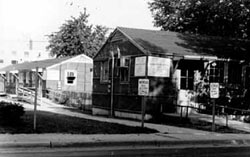
During the influx of students following World War II, Army barracks — equipped with a space heater and devoid of insulation — become home to students both with and without disabilities.
Photo courtesy of College of AHS
He once notified a professor that a class was to be moved from the third floor of a building to the first. The teacher erupted angrily and called Nugent “every name in the book,” Nugent recalls, because the professor had already carefully coordinated class times and location to be near his office. Ultimately, Nugent took the matter to the assistant provost, who ensured that the class was relocated to the ground floor.
“We had a lot of situations like that. That was the attitude of a lot of the faculty,” Nugent recalls. “It’s hard to explain the phenomena that went into changing people’s concepts and attitudes. It doesn’t happen just by talking to a person. Sometimes you have to hit them with something harder than that.”
He also had a lot of help. Nugent has many glowing examples of people who always seemed in tune with his mission. A former Champaign city engineer, for example, whose wife taught students with visual disabilities, would create curb cuts at Nugent’s request within 24 hours. One of Nugent’s early bus drivers told him, “As long as you work here, I’m going to work here,” and he drove for $1 an hour for 18
years before Nugent could convince the University to raise his wage.
And for every angry professor, there were others who would patiently work with Nugent through an entire departmental class schedule, moving sections as necessary so that all students could attend.
“There were so many ways that people contributed,” he adds. “It would take me months to describe them all.”
And it should be mentioned that in 1949, when the program was under threat of closure, Nugent had inquired of several other universities whether they’d be willing to house the program. None would except the Urbana campus, making it the first college campus to serve those with severe physical disabilities.
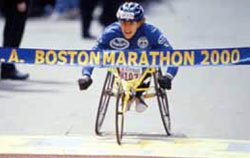
Jean Driscoll
Photo courtesy of College of AHS
Sports as the Great Equalizer
Of all the factors that earned DRES acceptance around campus, sports was one of the strongest. Illinois was the first university to develop a collegiate wheelchair sports program, and the reason was partly public relations.
“Sports contributed a lot to what we were able to achieve,” Nugent recalls. “It motivated people and also gave people an understanding what we were really like. One father wrote to The Daily Illini and said, ‘It may be a wonderful thing what the University is doing for these … people with disabilities, but what’s more important is what they’ve done for the general public.'”
The strong wheelchair sports tradition continues today, with DRES boasting 15 men’s and 14 women’s national basketball championships and some of the world’s best wheelchair athletes. Perhaps DRES’ most famous alumna is Jean Driscoll ’91 LAS, MS ’93 AHS, a graduate of Illinois who was born with spina bifida. She arrived just after Nugent’s retirement and went on to win eight Boston Marathons in the wheelchair division.
Now an associate director of development for the UI College of Applied Health Sciences (under which DRES operates), Driscoll recalls how in the late 1980s Hedrick recruited her out of her hometown of Milwaukee to play wheelchair basketball at Illinois. At first she was reluctant to leave Wisconsin for what she considered a rival state, but once she arrived in Urbana-Champaign, her “life just changed,” she says.
“Marty Morse ’84 AHS, MS ’87 AHS, who was the track and road racing coach, and Brad, who was coach of basketball, they helped you see the big picture. … I wasn’t dreaming that big before I came to Illinois,” Driscoll recalls. “I love the structure that was provided; I love the type of coaching that was provided. Not only were we coached there, but they were consummate teachers.”
***
In fall 1993 Ian Rice ’98 LAS was a freshman gymnast at Illinois when he fell from the high bar during practice. He dislocated a vertebra in his neck, paralyzing his legs and ending life as he knew it.
But a funny thing happened at rehab in St. Louis. Rice met some wheelchair athletes who asked him where he went to school. They were “super impressed” that he attended the U of I, Rice recalls. “I had no idea [that] if there was a place to be injured, this would be it, this would be the best place in the universe.”
When he returned to the Urbana campus, he began wheelchair racing. It gave him hope.
“After getting involved in wheelchair athletics and seeing the athletes and how able they were, how good they were and how happy they were, it really kind of opened my eyes to the possibility that this might work,” Rice says. “It rehabilitated me body and soul.”
Rice would graduate and go on to earn a doctoral degree at the University of Pittsburgh, where he studied wheelchair propulsion biomechanics. This fall, almost exactly 17 years after his injury, he was hired as an assistant professor of kinesiology and community health at the U of I.
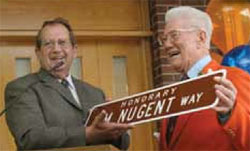
Mayor Jerry schweighart, honoring former director Tim Nugent with an “honorary Tim Nugent Way” in 2007
Photo courtesy of College of AHS
Reaching the Children Early
By the time that Hedrick, DRES’ current director, arrived at Illinois in 1977, the University had become a trendsetter in campus accessibility (indeed, he remembers it as “an oasis in the desert”). Still, much work remained to be done on behalf of those with disabilities.
One of Hedrick’s earlier roles was directing sports and recreation at DRES, but during the mid-1980s, he was also pursuing a doctoral degree. In light of that, he conducted an experiment in Kansas City, Mo., at what was then the only youth wheelchair sports program in the nation.
Hedrick generally speaks in long, running sentences when he broaches a topic he’s passionate about, but his voice falters as he recalls how people in Kansas City responded to his efforts to improve sports instruction for youth with disabilities.
“I had parents tearfully thanking me because their son or daughter with a disability said that for the first time they actually were coached,” Hedrick recalls. “They felt they had been given the same kind of opportunity and respect and training — and held to the same expectations — as their brothers and sisters and peers.
“I get overwhelmed now when I think back about those comments. And they were probably very critical to my career in helping me frame what I wanted to see us do at Illinois in outreach.”
Soon after Hedrick’s experience in Kansas City, DRES conducted its first summer sports camp on the Urbana campus for youth with disabilities, enrolling 16 children. This past year the program’s summer camps served more than 200.
In recent years DRES has worked with the Illinois High School Association to promote sports for children with disabilities and has arranged for DRES’ coaches and athletes to conduct clinics across the nation and around the world. The program is developing online resources for teaching sports to youth with disabilities.
“[Children with disabilities] get a taste of the wheelchair sports program, and they go, ‘This is great, I’d really like to do this, I like to play college sports!'” Hedrick adds. “And then you say, ‘You know what? The admissions bar at Illinois is pretty high. You’d better recalibrate your study habits and focus yourself a little more and make better grades.’ It’s just been marvelous in terms of reorienting the young people to set higher standards and maybe higher standards than their teachers or parents had for them.
“The carrot is to get here and be a part of this program, to experience this for four or five years instead of once a week. To get it daily.”
Ongoing Efforts
Outreach is just part of a program that continued to bloom after Nugent retired and Hedrick became director in 1995.
Nugent and his staff had created a legacy of architectural standards that became the components of future accessibility codes, including the Americans With Disabilities Act of 1990, the Fair Housing Amendments Act of 1988 and the Rehabilitation Act of 1973. Research at DRES has been the seed for myriad architectural features that shape buildings today, including seats with showers; hallway, doorway and toilet dimensions; wheelchair ramp characteristics; stairway features and more.
Today, DRES is one of the top producers of accessible college course content in the nation, with staff converting thousands of textbook pages and other materials to Braille, auditory readings and Web-accessible electronic content.
Accessibility initiatives have also branched to the Internet, with complex efforts to make websites friendlier to users with disabilities. For people with sight, hearing or motor challenges, the Internet may not be easy to navigate. Catherine Kudlick, professor of history at University of California, Davis, and president of the Disability History Association, calls Illinois a leader in electronic accessibility.
“Our electronic environment today is much like the physical environment of the last century, where there were all kinds of barriers as people devoted most of their energies to laying out streets, putting in pipes, directing traffic, etc., but only later tackling the problem that it was built for people in great physical condition,” she says.
“Today’s [disability activists] are looking for ways that we can build in ‘electronic curb cuts’ before it gets too expensive and complicated to add them on later. A site such as the one at University of Illinois is a terrific contribution to these efforts,” Kudlick adds. The site she refers to — itaccessibility.illinois.edu — includes straightforward information on laws and standards, HTML best practices, types of disabilities and other issues.
In recent years DRES has expanded its services to students with cognitive disabilities such as learning disorders, brain injuries, psychological disabilities and attention-deficit hyperactivity disorder (ADHD).
With help from other campus units, DRES provides free screenings of students who are in danger of dropping out to see if they have undiagnosed cognitive disorders; since 2000, 600 such students have been helped. While some 45 percent of them had been on academic probation or faced expulsion upon entering the program, that number fell to 2 percent after diagnosis and treatment or counseling. Grade-point averages rose significantly.
These days, DRES has some 30 full-time staff, serves hundreds of students every year and enjoys strong support from University administration and the College of Applied Health Sciences. Indeed, Nugent, who is still active on DRES committees, says current AHS Dean Tanya Montaleone Gallagher ’67 LAS, MA ’70 LAS, PHD ’71 LAS, has contributed mightily to the efforts.
And architectural accessibility efforts have not been forgotten. This fall, in a crowning achievement for the program, the University opened the first wing of Timothy J. Nugent Hall, the campus’s first new residence hall in 44 years and the most accessible in the country for students with severe disabilities (the building also houses students without disabilities). At the building dedication during Homecoming Weekend, Nugent called the new dorm “the culmination of 63 years.”
***
“The students who live [at Nugent Hall] will be able to open every exterior door, every security passage and their individual room doors without touching anything,” Hedrick said before the residence hall became operational this semester. “Each of the rooms will have a motorized ceiling lift that [students] can use to independently… get in and out of bed or go to the bathroom or get in and out of their chairs or require fewer [personal assistants] to help them do that.
“We’re the first non-hospital, large-scale facility in which those ceilings are going to be deployed.”
But Hedrick had an even greater reason to be excited about the state-of-the-art facility. While attending a tour of the residence hall shortly before it opened, he recognized a moment when the missions of DRES and the University of Illinois seemed to merge into one. As he followed the young, able-bodied tour guide from an entirely different University unit than his, Hedrick realized she knew more about building accessibility than he did — and he had never seen her before in his life.
Evensen is a freelance writer living in Champaign.

